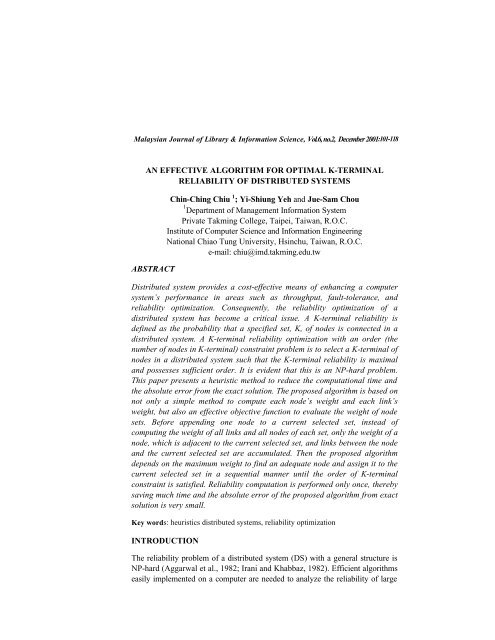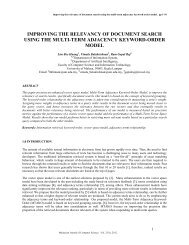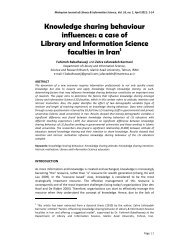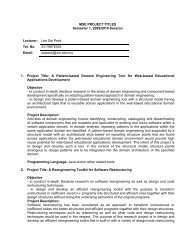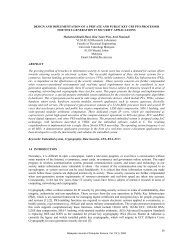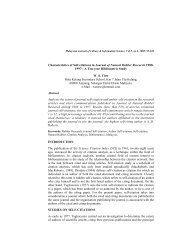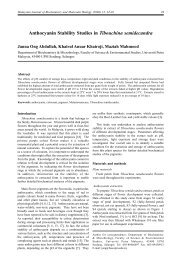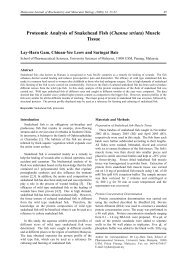Download1 - EJUM
Download1 - EJUM
Download1 - EJUM
You also want an ePaper? Increase the reach of your titles
YUMPU automatically turns print PDFs into web optimized ePapers that Google loves.
Chiu, C.C.; Yeh, Y.S. & Chou, J.S.networks. In addition, such algorithms should yield good approximations of thereliability when the networks are so large that the computational time becomesprohibitive.The topology of a DS with n processing elements (nodes) and e communicationlinks (links) can be characterized by an undirected graph G = (V, E) where Vdenotes a set of nodes, and E represents a set of links.These DS topologies can be characterized by their DS reliability, message-delay,or network capacity. These performance characteristics depend on manyproperties of G that represent the DS topology (Stankovic, 1984; Kumar andAgrawal, 1993): the number of ports at each node (degree, say d(v i ), of a nodev i ), and the number of links. Notably, the number of links directly impacts thesystem’s reliability.For an undirected graph G the K-terminal reliability of G, R(G k ), is theprobability that the set K of nodes of G is connected in G. Two special andwidely studied cases are those obtained for K = V and |K| = 2. For example, inFig. 2, the former K-terminal is K = {v 1 , v 2 , v 3 , v 4 , v 5 , v 6 , v 7 , v 8 }; the latterK-terminal is one of K = {v 1 , v 2 }, K = {v 1 , v 3 },…, K = { v 7 , v 8 }. The first isthe all-terminal reliability of G, the second is the 2-terminal reliability (Rai et al.,1987; Satyanarayana and Hagstrom, 1981; Torrieri, 1994). A typical networkreliability problem is to compute R(G k ). This is not easy since the reliabilityproblem for a general network has been shown to be inherently difficult and verylikely no efficient algorithm can be constructed for its solution. It has beenshown that the network reliability with respect to a network with generalstructure is NP-hard (Aggarwal and Rai, 1981; Lin and Chen, 1992). Veryrecently it was also established that even for planar networks the computation ofthe K-terminal reliability, for K ≠ V, is an NP-hard problem (Politof andSatyanarayana, 1986). The case for which K = V (all-terminal reliability) is atpresent undetermined for planar networks. The above results mean that it isunlikely that a polynomial algorithm to solve a general network reliabilityproblem will be found.This work largely focuses on how to compute nearly maximum systemreliability subject to the order K request of nodes constraint. For a large DS onvarious topologies, our results demonstrate that the proposed algorithm isreliable and efficient.102
Chiu, C.C.; Yeh, Y.S. & Chou, J.S.time and can quickly compute the weight of every node. The weight, say w(v i ),of node v i is formulate as:w ( v ) = 1 − q .id ( v i )Χ (1)z = 1i , k zwhereq i,j denotes the probability of failure of link e i,j that communicate node v i and v jthe index k z ∈1,...,nd(v i ) denotes the degree of node v i2 ≤ d(v i ) ≤ n-1n represents the number of nodes in G, n = |V|.The Eq. (1) is easily programmed and reduces many multiplicative operations. Ifthe degree of v i is d(v i ), the weight of v i can be computed in one subtraction andd(v i ) multiplication. Thus, we can obtain the weight of every node in nsubtractions and 2 × e multiplication.In the network, two nodes may contain many paths between them. A path’slength is between one and n-1. To reduce the computational time, we considerthe path in which the length is not greater than two. The following equation isused to evaluate the weight, say w(e i,j ), of link e i,j .yi,ji, j i,jz = 1w ( e ) = 1 − q ( q × p )Π , (2)i, kz kz , jWherep i,j (q i,j ) denotes the probability of success (failure) of link e i,jthe index k z ∈1,...,ny i,j denotes the number of paths with length two between v i and v jy i,j ≤ n − 2.The weight of e i,j can be computed in one subtraction and 2 × (y i,j +1)multiplication. Thus, in the worst case, when the graph is a complete graph, wecan obtain all of the weights of each link in n × (n-1)/2 subtractions andn × (n-1) × (n-2)/2 multiplication.In the same manner, if ε i, jdenotes no direct link exits, but y i,j is greater thantwo between v i and v j , the following equation is used to evaluate the weight, sayw(ε s, j), of ε i,j106
Effective Algorithm for Optimal K-Terminal Reliability of Distributed Systemw ( ε ) = 1 − ( q × p )i,jWherey i,j ≤ n − 2.yi,jΠ , (3)z = 1i, kz kz , jAssume not only that we have a selected set G k of nodes with reliability R ( G k),but also that the nodes in G k are all directly connected. If another set G k′ofnodes exists in which just one node is different from G k and G k′has one nodewhich is not directly connected with other nodes in G k ′ , then we saythat R ( G k) ≥ R ( Gk ′ ) for R( G k′ ) the reliability of set G k ′ .Fig. 1. (A) A selected set G k ={ v 1 , v 2 , v 3 } under a DS with six nodes and sevenlinks; (B) A selected set G k ′ ={ v 1 , v 2 , v 4 } under a DS with six nodes and sevenlinks.:denotes unselected node :denotes selected nodev 1 v 5 v 1v 5v 3v 4v 3 v 4v 2(A)v 6v 2v 6(B)By assuming that the 2-terminal reliability between v 1 and v 2 is R 1 , this relationcan be represented as R({v 1 , v 2 }) = R 1 , and R({v 1 , v 3 }) = R 2 , R({v 2 , v 3 }) = R 3 ,R({v 3 , v 4 }) = R 4 . In Fig. 1(A), we select nodes v 1 , v 2 and v 3 . Therefore, R({v 1 ,v 2 }) = R 1 , R({v 1 , v 3 }) = R 2 , R({v 2 , v 3 }) = R 3 . According to Fig. 1(B), we selectnodes v 1 , v 2 and v 4 , Therefore, R({v 1 , v 2 }) = R 1 , R({v 1 , v 4 }) = R 2 × R 4 andR({v 2 , v 4 }) = R 3 × R 4 . Because R 2 ≤ 1, R 3 ≤ 1 and R 4 ≤ 1, R 2 × R 4 ≤ R 2and R 3 × R 4 ≤ R 3 , the reliability of node v 1 , v 2 , v 3 ≥ the reliability of node v 1 ,v 2 , v 4 . Restated, R({v 1 , v 2 , v 3 }) ≥ R({v 1 , v 2 , v 4 }). However, this assumption isnot always true if (a) a path exists between v 4 and v 1 or between v 4 and v 2 , and(b) the reliability of the path is larger than the reliability between v 3 and v 1 andbetween v 3 and v 2 . For this reason, in some cases, the maximum reliabilitycannot be achieved using the proposed method.107
Chiu, C.C.; Yeh, Y.S. & Chou, J.S.This assumption is true if the reliability of any path between X and K is lessthan that of links between the set K of nodes. Restated, the proposed method canbe used to achieve maximum reliability.In each set of nodes, if the number of members of a set is |K|, the followingequation can be used to compute its weightw(G k ) = { [w( E Gk) + w(ε s, j)] / [|K| × (|K|-1)/2] + w( V Gk) / [(n-1) × |K|] },(4)wherew( E Gk)= Σw ( e i , j) and e i,j ∈a set E Gkof direct links between any two nodes inG kw( V Gk)= Σw( v j) and v j ∈a set V of nodes in G G kk.According to w( E Gk) and w( V Gk) in Eq. (4), only the sum of the weight of thelinks between v i and G k and the weight of node v i should be derived. Therefore,the weight of the K-terminal with another node, say v i , can be obtained easilyand efficiently using the equation as follows:w(G k Υ {v i }) = { [w( E Gk) + w( ε s, j) + Σw ( e i , j)vj ∈V G k, vi∉V G k, ei , j ∉EG k+[w( V Gk)+w(v i )] / [(n-1) × (|K|+1)] }. (5)] / [((|K|+1) × |K|)/2]Herein, a node of the heaviest weight is selected and serves as the starting nodefor deriving an adequate K-terminal. Before assigning one node to a selected set,the proposed algorithm only inspects those nodes that are adjacent to any nodeof the selected node for the reason of reducing computation time. In the firstnode assigned to a selected set, the proposed algorithm also probes nodes inV . The notation V represents a set of nodes which ε ε( Gk ) ε( G k ) s, jexist in G k.The Proposed Heuristic AlgorithmWe present a heuristic algorithm by carefully selecting the starting node v saccording to a node’s weight. Before assigning a node to the selected set, theproposed algorithm probes those nodes V adj(Gk) that are adjacent to any node of aselected node except for the selected nodes. After obtaining the K-terminal,108
Effective Algorithm for Optimal K-Terminal Reliability of Distributed SystemSYREL (Hariri and Raghavendra, 1987) is applied to compute the reliability.The proposed heuristic algorithm is to maximize K-terminal reliability of a DS.The detailed steps for KTR are described in Appendix 1.ILLUSTRATIVE EXAMPLESExample 1Figure 2 illustrates the topology of a DS with eight nodes and eleven links. Theproblem involves determining a subset, K-terminal, of the DS which includessome of the nodes v 1 , v 2 , …, v 8 whose reliability is maximal.Fig. 2. The DS with eight nodes and eleven links.v 2 v 3 v 4e2,3 e 3,4p 1,2 =0.89 p 1,7 =0.81e 4,5 p 1,8 =0.93 p 2,3 =0.85v 1 e 1,2 v 8 e 4,8 v 5 p 3,4 =0.91 p 4,5 =0.82ee 4,6 1,8p 4,6 =0.83 p 4,8 =0.96e 1,7 e 6,8 p 5,6 =0.87 p 6,7 =0.84e 5,6 p 6,8 =0.88e 6,7v 7 v 6In Step 1, each node’s weight is evaluated using Eq. (1). The weight of v 1 ,v 2 , …, and v 8 are 0.998537, 0.9835, 0.9865, 0.9998898, 0.9766, 0.9995756,0.9696 and 0.999664, respectively. Therefore, v 4 is the node with maximalweight and is served as starting node for obtaining an adequate K-terminal.Notably, G k is {v 4 }.In Step 2, because ε s, j does not exist, set Eε( Gk )to empty.In Step 3, each link’s weight is evaluated using Eq. (2).In Step 4, let V tmp = V = ∅ , w V ε( Gk )(G k) = w(v s ), w( E Gk) = 0.109
Chiu, C.C.; Yeh, Y.S. & Chou, J.S.In Step 5, for the set of nodes, (V adj(Gk) Υ V tmp )={v 3 , v 5 , v 6 , v 8 }, find v i , in(V adj(Gk) Υ V tmp ). Using Eq. (5) to evaluate weight, we have w({v 4 , v 3 }) =1.051885, w({v 4 , v 5 }) = 1.091156, w({v 4 , v 6 }) = 1.135257 and w({v 4 , v 8 }) =1.132041, respectively. Because the weight of {v 4 , v 6 } is maximum, v 6 isappended to G k . Notably, G k is {v 4 , v 6 }, V tmp = {}. The algorithm goes backstep 5 and continues.In Step 5, V adj(Gk) = {v 3 , v 5 , v 7 , v 8 } and V tmp = {}. Therefore, (V adj(Gk) Υ V tmp ) ={v 3 , v 5 , v 7 , v 8 }. Using Eq. (5) to evaluate weight, we have w({v 4 , v 6 , v 3 }) =0.776335, w({v 4 , v 6 , v 5 }) = 1.08682, w({v 4 , v 6 , v 7 }) = 0.752197 and w({v 4 , v 6 ,v 8 }) = 1.128572, respectively. Because the weight of {v 4 , v 6 , v 8 } is maximum,v 8 is appended to G k . Notably, G k is {v 4 , v 6 , v 8 }.In Step 6, the reliability of the K-terminal {v 4 , v 6 , v 8 } is computed usingSYREL. We have R({v 4 , v 6 , v 8 }) = 0.9966876 which has the maximumreliability under K request . The number of reliability computation is exactly one.The result is the same as in the K-terminal, which is derived by an exhaustivemethod.Example 2Figure 3 illustrates the topology of a DS with six nodes and eight links. Theproblem involves determining a subset, K-terminal, of the DS which includessome of the nodes v 1 , v 2 , …, v 6 whose reliability is maximal.Fig. 3. The DS with six nodes and eight links.e 1,2v 2 v 4e 2,4e 4,6 p 1,2 =0.82 p 1,3 =0.74p 2,3 =0.79 p 2,4 =0.76v 1 e 2,3 e 4,5v 6 p 3,5 =0.88 p 4,5 =0.86e 1,3 e 5,6p 4,6 =0.77 p 5,6 =0.81ev 3,53 v 5110
Effective Algorithm for Optimal K-Terminal Reliability of Distributed SystemIn Step 1, after evaluating each node’s weight using Eq. (1), v 5 is the heaviestnode and is served as starting node for obtaining an adequate K-terminal. Notethat G k is {v 5 }.In Step 2, after finding ε s, j, we have E ={ ε ε( Gk ) 5, 2}.In Step 3, each link’s weight is evaluated using Eq. (2) and each ε s, jin Eε( Gk )is evaluated using Eq. (3)In Step 4, let V tmp = V = {v ε( Gk ) 2}, w( V Gk) = w(v s ), w( E Gk) = 0.In Step 5, for sets of nodes, V adj(Gk) = {v 3 , v 4 , v 6 } and V tmp = {v 2 }, find v i , in(V adj(Gk) Υ V tmp ). Using Eq. (5) to compute the weight, we have w({v 5 , v 3 }) =1.079026, w({v 5 , v 4 }) = 0.1.146226, w({v 5 , v 6 }) = 1.131129 and w({v 5 , v 2 }) =1.093191. Because the weight of {v 5 , v 4 } is maximum, v 4 is appended to G k .Notably, G k is {v 5 , v 4 }.In Step 6, the reliability of the K-terminal {v 5 , v 4 } is computed using SYREL.We have R({v 5 , v 4 }) = 0.9452258 which has the maximum reliability underK request . The number of reliability computation is exactly one.The result is the same as in the K-terminal, which is derived by an exhaustivemethod.COMPARISON AND DISCUSSIONResults obtained from our algorithm were compared with those of exhaustivemethod and random method. Although capable of yielding the optimal solution,conventional techniques such as exhaustive method cannot effectively reduce thereliability count. An application occasionally requires an efficient algorithm tocompute reliability owing to resource considerations. Under this circumstance,deriving the optimal reliability may not be feasible. Instead, an efficient algorithmyielding approximate reliability is preferred.In contrast to the computer reliability problem, which is static-oriented, the KTRproblems in the DS are dynamic-oriented since many factors, e.g. DS topology, linkreliability, and the number of paths between each node, can significantly affect theefficiency of the algorithm(Aziz, 1997; Nakazawa, 1981; Makri and Psillakis,1997). Next, the accuracy and efficiency of the proposed algorithm are verified byimplementing simulation programs C language that are executed on a Pentium 133with 16M-DRAM on MS-Windows 95. We use many network topologies andgenerated several hundreds of data for simulation. The reliability of each link wasgenerated using a random number generator. For verifying the sensitivity of ourproposed algorithm, two data categories were given in different ranges. For the linkreliability, we considered the following range: 0.0~1.0, 0.5~1.0 and 0.8~1.0. For111
Chiu, C.C.; Yeh, Y.S. & Chou, J.S.the number of nodes in K-terminal, we consider that the k request is equal to 2, 3 and4, respectively. Table 1 (Appendix) presents the data on the results obtained usingdifferent methods for various DS topologies. In contrast to the exhaustive method,the number of reliability computations grew rapidly when the DS topology size isincreased.Table 1. Comparison with Other Methods Under the Range of Link Reliability in0.8 ~ 1.0.size exhaustive method RM & PM RM PMK requestN eMax_Rel NRC time(sec) NRC time(sec) absolute err absolute err12 21 4 0.9993535 1365 39.285 1 0.0288 0.2569579 0.000238712 21 3 0.9996854 220 8.462 1 0.0385 0.1513619 012 21 2 0.9999972 66 1.318 1 0.0199 0.2487065 019 29 4 0.9997547 3876 397.573 1 0.1026 0.1054234 019 29 3 0.9999088 912 49.689 1 0.0545 0.0791060 019 29 2 0.9999860 171 4.395 1 0.0257 0.0574796 025 31 4 0.9997928 12650 517.747 1 0.0409 0.4111645 025 31 3 0.9997537 2300 64.615 1 0.0281 0.5188945 0.000088225 31 2 0.9999160 300 5.714 1 0.0190 0.5145090 030 30 4 0.8558104 27405 224.175 1 0.0081 0.5393191 030 30 3 0.9207547 4060 29.780 1 0.0073 0.5715915 030 30 2 0.9984403 435 2.967 1 0.0068 0.6360298 030 31 4 0.9462816 27405 235.549 1 0.0086 0.6404305 030 31 3 0.9769668 4060 30.824 1 0.0076 0.5076126 030 31 2 0.9955244 435 3.022 1 0.0069 0.5205490 0Average 5710.7 107.7 1 0.02688 0.3839420 0.0000218n: the number of nodes in G, n = |V| e: the number of links in G,e = |E|NRC: the number of reliability computation K request : the order of K-terminalMax_Rel: maximum reliability satisfies our constraints RM: random methodPM: the proposed methodTables 2 and 3 (Appendix) list the results obtained using the random method andour proposed method for three different topologies (ring, bridge, hyper-cube) witheight nodes, respectively. These data show that the proposed method is moreeffective than the random method. When the DS topology and the link reliability arefixed, the order of K-terminal affects the average exact KTR solution. For example,the average exact KTR solution when K request is set to four is worse than when K requestis set to three or two. Without a loss of generality, the ratio of the average relativeerror was negatively correlated with the link reliability range and the number of links.The complexity of exhaustive method is O(n min(k,n-k) × m 2 ), where e denotes thenumber of edges, n represents the number of nodes, k represents the order of112
Effective Algorithm for Optimal K-Terminal Reliability of Distributed SystemK-terminal and m represents the number of paths of a selected K-terminal (Haririand Raghavendra, 1987). In the proposed algorithm, in the worst case, thecomplexity of evaluating the weight of each node is O(e) and each link is O(e × n),selecting an adequate K-terminal is O(n 3 ), and computing the reliability of theK-terminal using SYREL is O(m 2 ) (Hariri and Raghavendra, 1987). Therefore, thecomplexity of the proposed algorithm is max(O(n 3 ), O(m 2 )).Table 2. Random Method for Three DS Topologies with Eight Nodes.T(s) Lr K request AES HitR ARErrR UpErrBnd UpErrBndR ARErrRlnk ARErrRT4 0.326084 0 0.763126 0.417357 0.9577363 0.503812 0 0.829212 0.733091 0.9648452 0.886631 20 0.644896 0.842723 0.949601 0.7457454 0.638387 0 0.327150 0.320436 0.4794673 0.732953 0 0.355200 0.381432 0.5550652 0.963593 10 0.339181 0.457403 0.568255 0.3405104 0.897291 0 0.062130 0.081107 0.0916023 0.951859 0 0.088845 0.128657 0.1402032 0.987630 0 0.065677 0.138905 0.141486 0.072217 0.3861574 0.667060 0 0.532687 0.607786 0.8072013 0.716601 0 0.713274 0.890054 0.9245012 0.936734 0 0.369311 0.692768 0.734436 0.538424Ring (n8e8)Bridge (n8e11)(Fig. 3.)0.0~1.00.5~1.00.8~1.00.0~1.04 0.937299 0 0.195759 0.316703 0.3921773 0.965475 0 0.149418 0.318579 0.3194032 0.984210 0 0.094193 0.208457 0.214969 0.1464574 0.991387 0 0.042027 0.065841 0.0658413 0.997596 0 0.027991 0.056993 0.0571172 0.998858 0 0.018207 0.047118 0.04732 0.029408 0.230964 0.558898 0 0.561959 0.483877 0.9513213 0.759641 10 0.338054 0.395725 0.7486392 0.952303 0 0.388869 0.029266 0.648013 0.4296274 0.956241 0 0.048489 0.094668 0.0965773 0.972747 10 0.048654 0.103147 0.1049872 0.996003 20 0.041780 0.148503 0.151313 0.0463084 0.997204 10 0.003449 0.008865 0.0089143 0.998569 0 0.004190 0.009181 0.0091932 0.999521 0 0.002618 0.005022 0.005032 0.003419 0.159785Average 2.9 0.261346 (0.295691) (0.412415) 0.261346 0.261346Hypercube (n8e12)0.5~1.00.8~1.00.0~1.00.5~1.00.8~1.0T(s): represents the topology (size) of a DS.Lr : the range of link’s reliability, the reliability is obtained by random generator.AES : the value of average exact solution whose value is[ Σ( DSR opt]/( total simulation cases ).HitR : the ratio of obtaining exact solution.ARErrR : the value of ( Σ[ 1 −( DSRapp / DSRopt )])/( total simulation cases ) .113
Chiu, C.C.; Yeh, Y.S. & Chou, J.S.UpErrBnd : the upper error bound whose value isthe max(DSR opt -DSR app ) in total simulation cases.UpErrBndR : the value of the max[(DSR opt -DSR app )/ DSR opt ] in total simulationcases.ARErrRlnk : the value of average of ARErrR which are in same Lr and T(s).ARErrRT : the value of average of ARErrR which are in same T(s).(.): denotes the value is just for referenceDSR app : approximation solution which obtained by running heuristic algorithmDSR opt : optimal solution which obtained by running exhaustive search algorithm.Table 3. The Proposed Method for Three DS Topologies with Eight Nodes.T(s) Lr K request AES HitR ARErrR UpErrBnd UpErrBndR ARErrRlnk ARErrRT4 0.326084 90 0.021321 0.020473 0.1066053 0.503812 80 0.023556 0.049896 0.0995072 0.886631 90 0.000429 0.003579 0.004288 0.0151024 0.638387 80 0.012382 0.048862 0.1016263 0.732953 60 0.030009 0.086259 0.1276072 0.963593 90 0.002623 0.025769 0.026230 0.0150054 0.897291 50 0.007564 0.030080 0.0330393 0.951859 90 0.000397 0.003841 0.0039702 0.987630 90 0.000158 0.001548 0.001577 0.002706 0.0109384 0.667060 70 0.021885 0.056531 0.1517923 0.716601 90 0.007242 0.016407 0.0724162 0.936734 90 0.001230 0.012162 0.012595 0.010129Ring (n8e8)Bridge (n8e11)(Fig. 3.)0.0~1.00.5~1.00.8~1.00.0~1.04 0.937299 60 0.011850 0.060240 0.0636963 0.965475 50 0.011232 0.041352 0.0424742 0.984210 70 0.001616 0.009778 0.010454 0.0082334 0.991387 30 0.007660 0.018952 0.0189943 0.997596 80 0.001346 0.008294 0.0083232 0.998858 100 0.0 0.0 0.0 0.003002 0.0071214 0.558898 80 0.011515 0.070260 0.0929643 0.759641 70 0.016015 0.070496 0.0921352 0.952303 70 0.006012 0.035770 0.037123 0.0111814 0.956241 40 0.008914 0.027166 0.0294243 0.972747 90 0.000588 0.005626 0.0058832 0.996003 70 0.000746 0.005544 0.005570 0.0034164 0.997204 40 0.001738 0.004195 0.0042073 0.998569 70 0.000139 0.000810 0.0008102 0.999521 90 0.000011 0.000117 0.000117 0.000629 0.005075Average 73.3 0.007711 (0.026445) (0.042719) 0.007711 0.007711The mean of notations is described in footnote of Table 2.The value of AES is same as Table 2.Hypercube (n8e12)0.5~1.00.8~1.00.0~1.00.5~1.00.8~1.0Table 4 lists the results obtained using an exhaustive method and our proposed114
Effective Algorithm for Optimal K-Terminal Reliability of Distributed Systemmethod for three different topologies (ring, bridge, hyper-cube) with eight nodes,respectively.Table 4. The Average Exhaustive Method Execution Time and the ProposedMethod for Three DS Topologies with Eight Nodes.exhaustive metohdthe proposed methodT(s) Lr K request AT(sec) ATlnk(sec) ATT(sec) AT(sec) ATlnk(sec) ATT(sec)4 0.544 0.0083 0.313 0.0062 0.121 0.3260 0.004 0.00594 0.544 0.0083 0.297 0.0052 0.121 0.3205 0.004 0.00584 0.549 0.0083 0.319 0.0062 0.132 0.3333 0.3266 0.005 0.0061 0.0059Ring (n8e8)Bridge (n8e11)(Fig. 3.)0.0~1.00.5~1.00.8~1.00.0~1.04 0.791 0.0113 0.396 0.0072 0.148 0.4451 0.005 0.00794 0.791 0.0113 0.429 0.0082 0.143 0.4542 0.005 0.00804 0.775 0.0113 0.423 0.0082 0.137 0.4451 0.4481 0.005 0.0078 0.00794 1.610 0.0233 0.868 0.0162 0.280 0.9194 0.010 0.01624 1.621 0.0233 0.879 0.0162 0.286 0.9286 0.010 0.01644 1.615 0.0233 0.863 0.0152 0.286 0.9212 0.9231 0.010 0.0162 0.0163Average 0.5659 0.5659 0.5659 0.0100 0.0100 0.0100AT : the seconds of average execution time,AT = ( Σ( execution time))/( totalsimulationcase ) .ATlnk : the seconds of average execution time of same Lr and T(s).ATT : the seconds of average execution time of same T(s).The mean of other notations is described in footnote of Table 2.Hypercube (n8e12)0.5~1.00.8~1.00.0~1.00.5~1.00.8~1.0These data show that the proposed method is more efficient than the exhaustivemethod. In the random method, which obtains the exact solution below 3%, theaverage error from exact solution surpasses 0.26. In our simulation case, the115
Chiu, C.C.; Yeh, Y.S. & Chou, J.S.reliability count for the proposed algorithm is exactly one. The exact solution canbe obtained above 73.3%, in which the average error from exact solution is under0.008. In a few cases, an adequate node which has arrived for selected node setthrough many paths and the length of a great number of those paths exceeds two, thenode may be lost when using our equation for computing link’s weight. Notably, theproposed algorithm cannot obtain the exact solution.CONCLUSIONSComputing DS reliability is generally NP-hard. In this work, we presented aheuristic algorithm to obtain a K-terminal with sub-optimal reliability. Thereliability computation in our algorithm is only exactly one. Therefore, KTR inthe DS can provide the desired performance.In addition, the algorithm proposed herein is compared with an exhaustivemethod and a random method for various topologies. According to thatcomparison, the proposed algorithm is more efficient in terms of execution timefor a large DS. When the proposed method fails to provide an exact solution, theerror from the exact solution is only slight.REFERENCESAggarwal, K. K. and S. Rai. 1981. Reliability evaluation in computercommunication networks. IEEE Transactions on Reliability, R-30, no.1:32-35.Aggarwal, K. K., Y. C. Chopra, and J. S. Bajwa. 1982. Topological layout oflinks for optimizing the S-T reliability in a computer communication system.Microelectronics and Reliability, vol.22, no.3: 341-345.Aziz, M. A. 1997. Pathset enumeration of directed graphs by the set theoreticMethod. Microelectronics and Reliability, Vol. 37, no.5: 809-814.Hariri, Salim. and C. S. Raghavendra. 1987. SYREL: a symbolic reliabilityalgorithm based on path and cuset methods. IEEE Transactions onComputers, Vol.C-36, no.10: 1224-1232.Irani, K. B. and N. G. Khabbaz. 1982. A methodology for the design ofcommunication networks and the distribution of data in distributedsupercomputer systems. IEEE Transaction on Computers, Vol. C-31, no.5:420-434.116
Effective Algorithm for Optimal K-Terminal Reliability of Distributed SystemKumar, Anup. and Dharme P. Agrawal. 1993. A generalized algorithm forevaluation distributed program reliability. IEEE Transactions on Reliability,Vol.42, no.3: 416-426.Lin, M. S. and D. J. Chen. 1992. New reliability evaluation algorithms fordistributed computing systems. Journal of Information Science andEngineering, Vol.8, no.3: 353-391.Lin M. S., M. S. Chang and D. J. Chen. 1999. Efficient algorithms forreliability analysis of distributed computing systems. Journal of InformationScience and Engineering, Vol.117, no.1-2.Makri, F. S. and Z. M. Psillakis. 1997. Bound for reliability of k-withinconnected-(v,s) out-of (m,n) failure systems. Microelectronics andReliability, Vol.37, no.8: 1217-1224.Nakazawa, H. 1981. Decompositon methos for computing the reliability ofcomplex networks. IEEE Transactions on Reliability, Vol. R-32, no.2:289-292.Politof, T. and A. Satyanarayana. 1986. Efficient algorithms for reliabilityanalysis of planar netwotks—a survey. IEEE Transactions on Reliability,Vol.R-35, no.3: 252-259.Rai, S., A. K. Sarje, E. V. Prasad and A. Kumar. 1987. Two recursive forcomputing the reliability of k-out-of-n systems. IEEE Transactions onReliability, Vol.R-36, no.2: 261-265.Satyanarayana, A., and J. N. Hagstrom. 1981. A new algorithm for thereliability analysis of multi-terminal networks. IEEE Transactions onReliability, Vol.R-30, no.4: 325-333.Stankovic, J. A. 1984. A perspective on distributed computer systems. IEEETransaction on Computer, Vol.c-33, no.12: 1102-1115.Torrieri, Don. 1994. Calculation of node-pair reliability in large networks withunreliable nodes. IEEE Transactions on Reliability, Vol.43, no.3: 375-377.117
Chiu, C.C.; Yeh, Y.S. & Chou, J.S.Appendix 1This appendix describes the detail steps of KTR.Algorithm KTRStep 0 Initialize, read system parameters: n, e; read the order K request ofK-terminal.Random generate probability p i,j of each e i,j in G.Step 1 Evaluate the weight of each node using Eq. (1) and choose the heaviestone as the starting node, say v s , for deriving an adequate K-terminal. Notably,G k is initialized to {v s }.Step 2 Find each ε s, j and insert it into a set E of ε ε( Gk ) s, j .Step 3 Evaluate the weight of each link using Eq. (2).Evaluate the weight of each ε s, jin Eε( Gkusing Eq. (3).)Step 4 Let V tmp = V . /* V ε( Gk ) tmp denotes a set of nodes */Let w( V Gk) = w(v s ).Let w( E Gk) = 0.Step 5 Dowhile (|G k |


